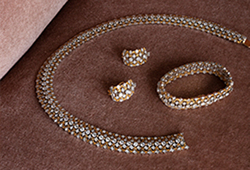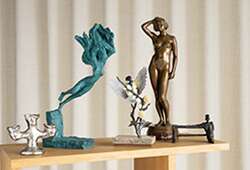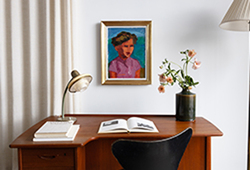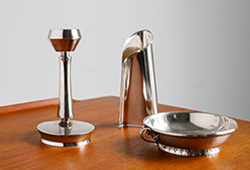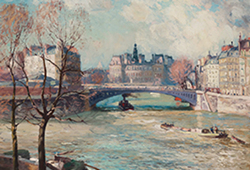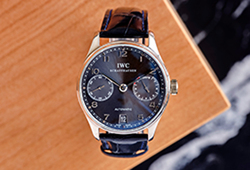Arman (Armand Pierre Fernandez)
"Monochrome Accumulation"
Signed Arman. Executed in 1986-89. Marked No. S.001 on verso. Mixed media, acrylic and tubes (Cadmium Red Medium) on canvas 77.5 x 50 cm.
Provenance
Vrej Baghoomian Gallery, New York.
Private collection, Sweden.
Literature
Donald Kuspit, "Arman - Monochrome Accumulations, 1986-89. Catalogue Raisonné", 1990, illustrated full page, p 121.
More information
”In 1956, I lost a bet with my friend Yves Klein and the penalty was to abandon my own works and do only monochrome paintings. I tried for two weeks with only one color – yellow. Yves understood my distress and decided not to bind me to my promise.
During the following years, I had several encounters with colors. From the way I presented my finished works of accumulations, to broken, sliced, or smashed objects on colored backgrounds using only black, white and red. Or, to the more direct use of colors, by using paint tubes with blobs and ribbons of colors embedded in plastic. And at the same time, I continued to make drawings and gouaches which included silk-screens and lithographs.
About three and a half years ago, I had the urge to renew some of the aspects of tubes and paints embedded in plastic. But, this time directly on canvas and without plastic. Most of the results were interesting but somehow unequal to some of my best works made between 1966 and 1969.
One day my friend Tom Andersson, saw these paintings and was attracted to two of them in particular. One was a white monochromatic accumulation of paint tubes on white canvas and the other was a blue monochromatic accumulation of paint tubes on white canvas. After a talk about the potential of these two works, he then commissioned me to make a body of monochrome paint tubes paintings in New York and became my assistant for the project. We started some months later with a large quantity of acrylic colors in tubes, some paint, some brushes, and different size canvases. Experimenting by myself first before we started, I made three monochrome accumulations on white on white canvas, a green on green canvas and a blue on blue canvas. The difference was that I painted the canvases with the same color as the paint tubes that I was going to use on it.
When I started to use the colored canvases I realized that the first ones were good but not good enough. I decided to cover the tubes themselves with the same color form the tubes. I tried to accomplish this by coloring the tubes after the accumulations were dry and, the tubes affixed to the canvases with small brushes repainting each tube. The result was preferable. I then had a better unity in the painting but the traces of the brush strokes on the paint tubes disturbed me.
The solution came during manipulation of the tubes to create the accumulation. Pressing to get ribbons or blobs of paint, the paint tubes were getting stained by the color after several handlings. The aspect of the tubes smeared with their own color hit me on the spot and, I started to systematically cover the tubes with color by hand before affixing them on the colored canvas. The result was right. The monochrome accumulations were born. The sensuality of the color, the superposition of color on color, until the accumulation of the colored tubes blended the elements together so perfectly that it became clear that I did not have to look for another solution. The variations of the ribbons, the blobs, the crossing of color lead to interesting painting. But, the plain accumulative ones are today my favorites. I am sure now that Yves Klein would have approved it completely because at the end, he really won his bet.”
Arman, New York 1989
Designer
Arman (Pierre Fernandez, born in Nice in 1928) moved to Paris after graduation to study archaeology and oriental art. After returning to Nice in 1953, he devoted himself instead to abstract art and began collaborating with Yves Klein, which was to have a significant impact on his artistic development. After a typographical error in an exhibition catalogue at the legendary Galerie Iris Clert in Paris, in which the letter "d" had dropped from his name, Arman decided that henceforth he would sign his works only "Arman".
In the late 1950s, he began working with sculptures, first the series Accumulations with everyday objects and then Poubelles consisting of rubbish.
In 1960, Arman co-founded the Nouveau Réalisme group with Jean Tinguely and Daniel Spoerri, among others. Later César, Niki de Saint Phalle and Christo joined. The group opposed informal art and became the French equivalent of English and American pop art.
During the 1960s, Arman travelled to New York for the first time, where he exhibited at the Cordier-Warren Gallery and MoMA. He continued to work with sculptures through different series such as 'Coupes' (sawed and sliced objects), 'Colères' (disintegrated and broken objects), 'Combustions' (burnt objects) and 'Inclusioni' (assemblage of objects enclosed in polyester resin).
Arman's work was shown both at the Stedelijk Museum, Amsterdam (1964) and at the Venice Biennale (1968) in the following years. In the 1970s, he created assemblages with cement and car parts in collaboration with Renault. In 1973 he became an American citizen when he moved to New York.
During the last twenty years of his life, Arman continued to work with different materials and techniques. He has executed several monumental works such as the bronze work "A la République" (1984) in the Palais de l'Élysée, Paris and the work "Espoir de Paix" (1995) in Beirut, an assemblage of cement and tanks. It is still the world's largest sculpture.
Arman died in 2005 in New York. During his lifetime, he participated in almost 500 solo exhibitions. His works are today included in collections at MoMA, NY, The National Gallery of Art, Washington, Tate Modern, London and Musée d'Art Moderne et d'Art Contemporain, Nice.
Read more




